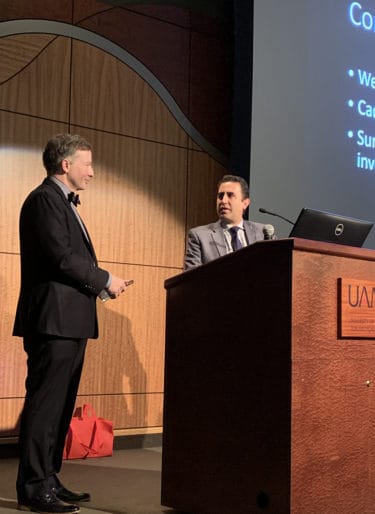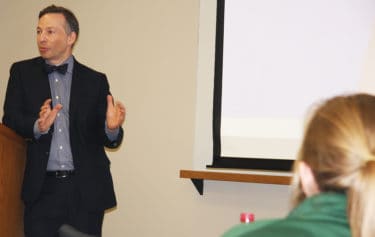Flanigan-Boop Lecturer: Anatomy Research Benefits Patients
| Despite all the centuries physicians have studied the human body, its anatomy still has secrets to reveal that can improve the treatment of patients and their health outcomes, said R. Shane Tubbs, Ph.D., professor of neurosurgery and cell biology, and director of surgical anatomy at Tulane University in New Orleans.
Tubbs spoke Oct. 11 to dozens of residents, students and faculty as part of the Flanigan-Boop Endowed Lectureship in Spinal Neurosurgery.
The lecture was part of three days of events celebrating the 50th anniversary of the clinical training program in neurosurgery at UAMS.
J.D. Day, M.D., chair of the UAMS Department of Neurosurgery, on Oct. 10 was invested as the Robert Watson, M.D., Chair in Neurosurgery. On Oct. 12, the UAMS Neurosciences Update provided a showcase of the most up-to-date and minimally invasive surgical techniques performed at UAMS. Sixteen speakers each gave 15-minute presentations of the latest research from faculty in neurosurgery and neurology covering subjects ranging from cancer genomics and epilepsy surgery to pediatric spine deformity and treatment options for aneurysms and stroke.

Tubbs, left, listens as Noojan Kazemi, M.D., right, asks him a question during a question-and-answer session after Tubbs’ lecture.
Flanigan-Boop lecturer Tubbs presented “Spinal Anatomy Research: Quo Vadis and Relevance to Spine Surgeons in 2019?” He is editor of the 41st and newly released 42nd editions of “Gray’s Anatomy,” long considered the ‘bible’ of anatomy, as well as author of more than 30 books and over 1,500 peer-reviewed publications.
“We still know very little about spinal anatomy, no matter what someone tells you,” Tubbs said. “We’re discovering things that we never knew existed in the spine after hundreds of years of study. It’s an exciting time to be in this field.”
Tubbs said he and his research team use “reverse translational research in anatomy” to speed up the process by which research makes it from its earliest stage to a practical application for patients. The average time that takes is 17 years, he said, but his team’s approach accomplishes that in 3.2 years.
“What we do with reverse translational research is go to surgeons and ask them what problems they have encountered in the operating room and what complications they have seen with patients,” Tubbs said. “We also ask if there’s an anatomical study we can devise to address that problem and help patients in the here and now.”
Often after he and his team publish their findings, Tubbs said, their work is picked up by others around the world and other researchers expand on it.
“We’ve been doing this for 25 years, and from it we’ve developed new foams, nerve grafts and surgical procedures,” Tubbs said. “We’ve improved patient care and offered surgeons a larger tool box to use for their patients.”
For much of the lecture, Tubbs reviewed his research findings regarding the spine. Some parts of the spine have been identified and known for a long time but in many cases how they interrelate with other tissues or anatomical structures isn’t. His research even has revealed small, previously overlooked features.
Tubbs spoke earlier in the day to the neurosurgery residents about how to approach writing for academic journals and improve the chances of being accepted for publications.
People are not taught how to write in medical school, Tubbs said. He advised that as writers they should always have an idea of what publication they want to submit an article to before they even start.
“My biggest suggestion is ask yourself what mentality you want to have in writing,” he said. “You want to think like your reviewers. Are they surgeons or statisticians or something else? You want to think like them with every word you type in.”

Tubbs talks to residents about the importance of writing in getting research findings published and how the process of academic publishing works.
Tubbs then took the neurosurgical residents through an anatomical dissection examining the back of the neck and top of the spine from the shoulders to the base of the skull.
“The opportunity to have Dr. Tubbs lead a dissection for our residents is an incredible one,” said Noojan Kazemi, M.D., associate professor in the UAMS Department of Neurosurgery. “Someone of his renown is a tremendous boost to the residents for their learning and it is a real honor to host him here for the Flanigan-Boop lecture and for UAMS in general.”
